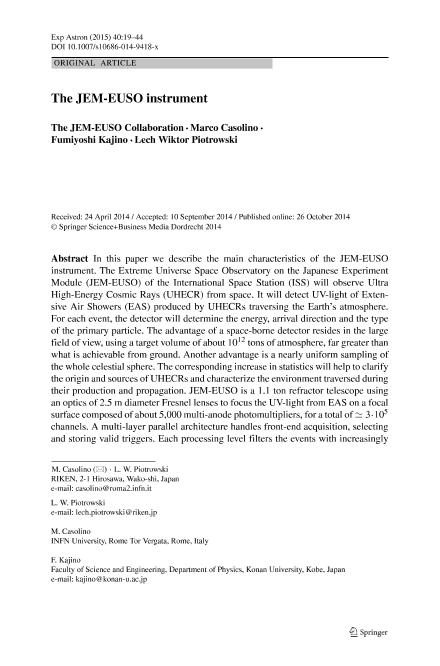Artículo
The JEM-EUSO instrument
Adams, J. H.; Ahmad, S.; Albert, J. N.; Allard, D.; Anchordoqui, L.; Andreev, V.; Anzalone, A.; Arai, Y.; Asano, K.; Ave Pernas, M.; Baragatti, P.; Barrillon, P.; Batsch, T.; Bayer, J.; Bechini, R.; Belenguer, T.; Bellotti, R.; Belov, K.; Berlind, A. A.; Bertaina, M.; Biermann, P. L.; Biktemerova, S.; Blaksley, C.; Blanc, N.; Blecki, J.; Blin,Bondil, S.; Blumer, J.; Bobik, P.; Bogomilov, M.; Supanitsky, Alberto Daniel ; Casolino, Marco; Kajino, Fumiyoshi; Piotrowski, Lech Wiktor; The JEM-EUSO Collaboration
; Casolino, Marco; Kajino, Fumiyoshi; Piotrowski, Lech Wiktor; The JEM-EUSO Collaboration
 ; Casolino, Marco; Kajino, Fumiyoshi; Piotrowski, Lech Wiktor; The JEM-EUSO Collaboration
; Casolino, Marco; Kajino, Fumiyoshi; Piotrowski, Lech Wiktor; The JEM-EUSO Collaboration
Fecha de publicación:
11/2015
Editorial:
Springer
Revista:
Experimental Astronomy
ISSN:
0922-6435
Idioma:
Inglés
Tipo de recurso:
Artículo publicado
Clasificación temática:
Resumen
In this paper we describe the main characteristics of the JEM-EUSO instrument. The Extreme Universe Space Observatory on the Japanese Experiment Module (JEM-EUSO) of the International Space Station (ISS) will observe Ultra High-Energy Cosmic Rays (UHECR) from space. It will detect UV-light of Extensive Air Showers (EAS) produced by UHECRs traversing the Earth?s atmosphere. For each event, the detector will determine the energy, arrival direction and the type of the primary particle. The advantage of a space-borne detector resides in the largefield of view, using a target volume of about 10 12 tons of atmosphere, far greater than what is achievable from ground. Another advantage is a nearly uniform sampling of the whole celestial sphere. The corresponding increase in statistics will help to clarify the origin and sources of UHECRs and characterize the environment traversed during their production and propagation. JEM-EUSO is a 1.1 ton refractor telescope using an optics of 2.5 m diameter Fresnel lenses to focus the UV-light from EAS on a focal surface composed of about 5000 multi-anode photomultipliers, for a total of 3x10^5 channels. A multi-layer parallel architecture handles front-end acquisition, selecting and storing valid triggers. Each processing level filters the events with increasingly complex algorithms using FPGAs and DSPs to reject spurious events and reduce thedata rate to a value compatible with downlink constraints.
Palabras clave:
Uhecr
,
International Space Station
,
Cosmic Rays
Archivos asociados
Licencia
Identificadores
Colecciones
Articulos(IAFE)
Articulos de INST.DE ASTRONOMIA Y FISICA DEL ESPACIO(I)
Articulos de INST.DE ASTRONOMIA Y FISICA DEL ESPACIO(I)
Citación
Adams, J. H.; Ahmad, S.; Albert, J. N.; Allard, D.; Anchordoqui, L.; et al.; The JEM-EUSO instrument; Springer; Experimental Astronomy; 40; 1; 11-2015; 19-44
Compartir
Altmétricas



